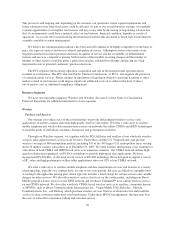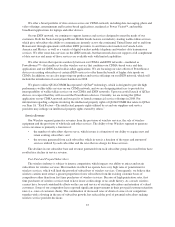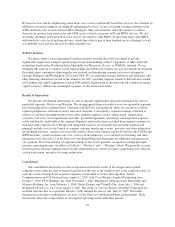Sprint - Nextel 2007 Annual Report Download - page 39
Download and view the complete annual report
Please find page 39 of the 2007 Sprint - Nextel annual report below. You can navigate through the pages in the report by either clicking on the pages listed below, or by using the keyword search tool below to find specific information within the annual report.We offer a broad portfolio of data services across our CDMA network, including data messaging, photo and
video offerings, entertainment and location-based applications, marketed as Power VisionSM, and mobile
broadband applications for laptops and other devices.
On our iDEN network, we continue to support features and services designed to meet the needs of our
customers. Both the Nextel and prepaid Boost Mobile brands feature our industry-leading walkie-talkie services,
which give subscribers the ability to communicate instantly across the continental United States and to and from
Hawaii and, through agreements with other iDEN providers, to and from select markets in Canada, Latin
America and Mexico, as well as a variety of digital wireless mobile telephone and wireless data transmission
services. We offer some data services on the iDEN network, but that network does not support a full complement
of data services and many of those services are available only with limited capabilities.
We offer devices that operate seamlessly between our CDMA and iDEN networks—marketed as
PowerSourceTM—that enable us to offer wireless service that combines our CDMA-based voice and data
applications and our iDEN-based walkie-talkie applications. We are focusing our sales efforts of PowerSource
devices on existing subscribers of certain iDEN services to offer them the benefit of higher data speeds on
CDMA. In addition, we are also improving our product and service offerings on our iDEN network, which will
include the introduction of several new handsets in 2008.
We plan to utilize QUALCOMM Incorporated’s QChat®technology, which is designed to provide high
performance walkie-talkie services on our CDMA network, and we are designing interfaces to provide for
interoperability of walkie-talkie services on our CDMA and iDEN networks. Upon successful launch of QChat
devices, we expect that they will succeed the PowerSource devices. Currently, we are testing the QChat
application on our CDMA network and our goal is to launch commercial service offerings in 2008. For
information regarding a dispute involving the intellectual property rights of QUALCOMM that relate to QChat,
see Item 1A. “Risk Factors—The intellectual property rights utilized by us and our suppliers and service
providers may infringe on intellectual property rights owned by others.”
Service Revenue
Our Wireless segment generates revenues from the provision of wireless services, the sale of wireless
equipment and the provision of wholesale and other services. The ability of our Wireless segment to generate
service revenues is primarily a function of:
• the number of subscribers that we serve, which in turn is a function of our ability to acquire new and
retain existing subscribers; and
• the revenue generated from each subscriber, which in turn is a function of the types and amount of
services utilized by each subscriber and the rates that we charge for those services.
The declines in our subscriber base and revenue generated from each subscriber group discussed below have
resulted in a decline in service revenue.
Post-Paid and Prepaid Subscribers
The wireless industry is subject to intense competition, which impacts our ability to attract and retain
subscribers for wireless services. Most markets in which we operate have very high rates of penetration for
wireless services, which will limit the growth of subscribers of wireless services. Consequently, we believe that
wireless carriers must attract a greater proportion of new subscribers from the existing customer bases of
competitors rather than from first time purchasers of wireless services. Because of high penetration rates, first
time purchasers of wireless services tend to have lower credit ratings or no credit history. As a result, wireless
carriers have focused considerable efforts on the care and service of existing subscribers and retention of valued
customers. Some of our competitors have reported significant improvements in their post-paid customer retention
rates (i.e., rates of customer churn). The combination of decreased rates of churn of some of our competitors,
together with a slowing in the rate of subscriber growth, has reduced the pool of potential subscribers making
wireless service provider decisions.
37
























